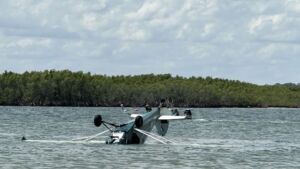Here are your stories for today...
Be safe out there!
Tom
Four survive after pilot loses control, crashing into parked planes at Kalispell Airport
Preliminary investigation shows pilot lost control of plane and crashed into several parked planes, igniting multiple fires.
By: MTN News
UPDATE: 8:01 p.m.- August 11, 2025
Preliminary investigation into the crash indicates that the pilot of the incoming aircraft with four occupants attempted to land when the pilot lost control, crashing onto the runway.
that the pilot of the incoming aircraft with four occupants attempted to land when the pilot lost control, crashing onto the runway.
The plane then struck several parked airplanes, igniting fires on multiple planes. All four occupants of the aircraft were from out of state, according to a press release.
UPDATE: 3:08 p.m. - August 11, 2025
Two victims were treated for minor injuries after a Monday afternoon small plane crash in Kalispell.
Monday afternoon small plane crash in Kalispell.
Kalispell Fire Chief Jay Hagen tells MTN that reports indicate that a small plane was on approach to the Kalispell City Airport when something unusual happened.
The aircraft crashed on the runway, skidded, hit another small plane and then burst into flames. The fire then spread into a grassy part of the taxiway.
Kalispell police and fire, Evergreen and Smith Valley fire and Whitefish fire all responded to the scene.
A total of four passengers made it off the crashed plane safely. Nobody was on board a stationary plane that was crashed into, Hagen said.
The FAA will take control of the investigation.
- Information from Sean Wells included in this report.
(first report: 2:55 p.m. - August 11, 2025)
Crews are on the scene of an apparent plane crash at the Kalispell City Airport.
Initial reports indicate a small plane had an issue on the runway and crashed into another plane on the taxiway.
A fire broke out following the collision.
Flathead County Sheriff Brian Heino tells MTN that the extent of any injuries is not known at this time.
https://www.kpax.com/news/local-news/flathead-county/small-plane-crashes-at-kalispell-city-airport
No injuries reported after banner plane crashes in water near Ponce Inlet
Crash reported near Disappearing Island
Jacob Langston, Digital Journalist
VOLUSIA COUNTY, Fla. – No injuries were reported after a banner plane crashed into the water in the Ponce Inlet area in Volusia County on Monday afternoon, officials said.
reported after a banner plane crashed into the water in the Ponce Inlet area in Volusia County on Monday afternoon, officials said.
Video posted to the Town of Ponce Inlet’s Facebook shows what looks like the small plane attempting to land in the water near Disappearing Island, a popular sandbar that attracts boaters.
The Federal Aviation Administration told News 6 that the Piper PA-12 crashed into the waters near Ponce Inlet around 1 p.m. with only a single pilot onboard.
Officials said the Ponce Inlet Fire Rescue responded to the crash along with the U.S. Coast Guard and the Volusia County Beach Patrol.
The FAA is investigating the crash.
https://www.clickorlando.com/news/local/2025/08/11/video-no-injuries-reported-after-banner-plane-crashes-in-water-near-ponce-inlet/
NTSB Prelim: Orlican S R O M-8 Eagle
A New Propeller Was Installed And The Accident Flight Was A Test Flight With The Pilot/Owner And A Flight Instructor
Location: Lake Worth Beach, FL Accident Number: ERA25LA278
Date & Time: July 28, 2025, 16:24 Local Registration: N974FL
Aircraft: Orlican S R O M-8 Eagle Injuries: 6 Minor, 1 None
Flight Conducted Under: Part 91: General aviation - Flight test
On July 28, 2025, about 16:24 eastern daylight time, an Orlican M-8, N974FL, was substantially damaged when it was involved in an accident near Lake Worth Beach, Florida. The flight instructor sustained minor injuries, the private pilot sustained no injuries, and five people on the ground sustained minor injuries. The airplane was operated as a Title 14 Code of Federal Regulations Part 91 flight test.
The pilot/owner reported that he had brought the airplane to the United States to have maintenance completed. During the maintenance work a new propeller was installed and the accident flight was a test flight with the pilot/owner and a flight instructor where they would calibrate the new propeller. The pilot/owner continued that after departing runway 10 at Palm Beach County Park Airport (LNA), West Palm Beach, Florida, about a minute into the flight they experienced a total loss of engine power. They performed a forced landing to a roadway near a park during which the airplane struck a tree and a vehicle on the roadway resulting in substantial damage to the fuselage, both wings, engine mount, and empennage.
Postaccident examination of the airplane found there were about 27 gallons of 100LL aviation fuel present between both the wing fuel tanks. Postaccident photos showed that the electric fuel pump switch, avionics switch, and strobe switch were in the ON position. The pilot/owner reported that the airplane was usually used for “island hopping” in the Caribbean and that he would bring to the United States to have maintenance work completed.
The airplane was retained for further examination.
FMI: www.ntsb.gov

Today in History
40 Years ago today: On 12 August 1985 Japan Air Lines flight JL123, a Boeing 747SR, crashed near Ueno, Japan, following a pressure bulkhead failure, killing 520 occupants; 4 survived the accident.
| Date: | Monday 12 August 1985 |
| Time: | 18:56 |
| Type: | Boeing 747SR-46 |
| Owner/operator: | Japan Air Lines - JAL |
| Registration: | JA8119 |
| MSN: | 20783/230 |
| Year of manufacture: | 1974 |
| Total airframe hrs: | 25030 hours |
| Cycles: | 18835 flights |
| Engine model: | Pratt & Whitney JT9D-7A |
| Fatalities: | Fatalities: 520 / Occupants: 524 |
| Other fatalities: | 0 |
| Aircraft damage: | Destroyed, written off |
| Category: | Accident |
| Location: | 26 km SW of Ueno Village, Tano district, Gunma Prefecture - Japan |
| Phase: | En route |
| Nature: | Passenger - Scheduled |
| Departure airport: | Tokyo-Haneda Airport (HND/RJTT) |
| Destination airport: | Osaka-Itami Airport (ITM/RJOO) |
| Investigating agency: | AAIC |
| Confidence Rating: | Accident investigation report completed and information captured |
Narrative:
Japan Air Lines flight JL123, a Boeing 747SR, crashed near Ueno, Japan, following a pressure bulkhead failure, killing 520 occupants; 4 survived the accident.
JA8119 was a Japan Air Lines Boeing 747SR, a short range variant of the Boeing 747 Series 100. The was aircraft specifically configured for domestic flights with a high density seating arrangement.
On June 2, 1978 the aircraft operated on a flight to Osaka (ITM). It floated after touchdown and on the second touchdown the tail struck the runway. The aircraft sustained substantial damage to the rear underside of the fuselage. The rear pressure bulkhead was cracked as well. The aircraft was repaired by Boeing. Engineers replaced the lower part of the rear fuselage and a portion of the lower half of the bulkhead.
Seven years later, on August 12, 1985, JA8119 had completed four domestic flights when it landed at Tokyo-Haneda (HND) at 17:17. The next flight was to be flight 123 to Osaka (ITM). The aircraft took off from Tokyo-Haneda at 18:12. Twelve minutes later, while climbing through 23900 feet at a speed of 300 knots, an unusual vibration occurred. An impact force raised the nose of the aircraft and control problems were experienced. A decompression had occurred and the crew got indications of problems with the R5 door. In fact, the rear pressure bulkhead had ruptured, causing serious damage to the rear of the plane. A portion of its vertical fin, measuring 5 m together with the section of the tailcone containing the auxiliary power unit (APU) were ripped off the plane. Due to the damage, the hydraulic pressure dropped and ailerons, elevators and yaw damper became inoperative. Controlling the plane was very difficult as the airplane experienced dutch rolls and phugoid oscillations (unusual movement in which altitude and speed change significantly in a 20-100 seconds cycle without change of angle of attack).
The aircraft started to descend to 6600 feet while the crew tried to control the aircraft by using engine thrust. Upon reaching 6600 feet the airspeed had dropped to 108 knots. The aircraft then climbed with a 39 degree pitch-up to a maximum of approx. 13400 feet and started to descend again. At 18:56 JAL123 finally brushed against a tree covered ridge, continued and struck the Osutaka Ridge, bursting into flames.
CAUSE: "It is estimated that this accident was caused by deterioration of flying quality and loss of primary flight control functions due to rupture of the aft pressure bulkhead of the aircraft, and the subsequent ruptures of a part of the fuselage tail, vertical fin and hydraulical flight control systems.
The reason why the aft pressure bulkhead was ruptured in flight is estimated to be that the strength of the said bulkhead was reduced due to fatigue cracks propagating at the spliced portion of the bulkhead's webs to the extent that it became unable to endure the cabin pressure in flight at that time.
The initiation and propagation of the fatigue cracks are attributable to the improper repairs of the said bulkhead conducted in 1978, and it is estimated that the fatigue cracks having not be found in the later maintenance inspection is contributive to their propagation leading to the rupture of the said bulkhead."
